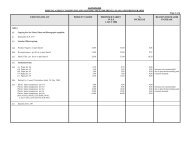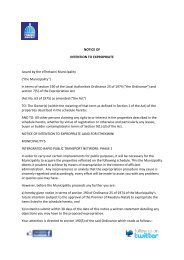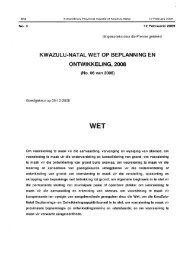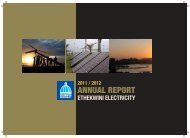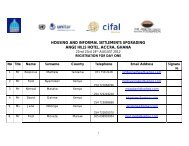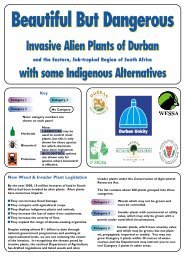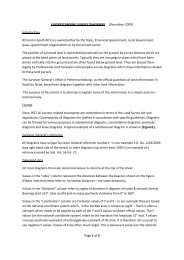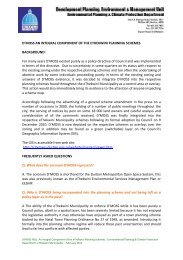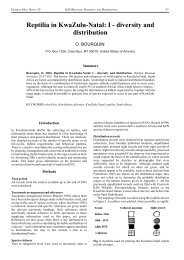Mullin, S. K., Taylor, P. J. & Pillay, N. 2004. Skull size and ... - Durban
Mullin, S. K., Taylor, P. J. & Pillay, N. 2004. Skull size and ... - Durban
Mullin, S. K., Taylor, P. J. & Pillay, N. 2004. Skull size and ... - Durban
Create successful ePaper yourself
Turn your PDF publications into a flip-book with our unique Google optimized e-Paper software.
MULLIN_08 13/08/04 12:45 Page 24<br />
<strong>Mullin</strong> S. K. et al.<br />
with our findings: Mozambican <strong>and</strong> Malawian<br />
specimens appeared to be most similar to Zambian<br />
material, which appears to be part of a D. rufulus<br />
complex. It has been previously suggested that<br />
two D. incomtus subspecies found in southern<br />
Africa (D. i. incomtus, D. i. nudipes) were distinguished<br />
by pelage colour alone (Rautenbach 1982).<br />
The only difference between D. i. fuscus from<br />
Zimbabwe <strong>and</strong> D. i. incomtus from KwaZulu-<br />
Natal appears to be the darker dorsal pelage with<br />
less yellow grizzling in D. i. fuscus (Fitzsimons 1920).<br />
Ellerman et al. (1941) were the first to include<br />
Limpopo <strong>and</strong> Mpumalanga Province specimens<br />
in D. i. incomtus with previously described specimens<br />
from the KwaZulu-Natal Province.<br />
Rautenbach (1982) concurred with this but<br />
stated that this arrangement was temporary <strong>and</strong><br />
needed to be confirmed with morphological<br />
studies, something that was not examined until<br />
recently (<strong>Mullin</strong> et al. 2002). Roberts (1951) named<br />
D. i. incomtus from Hectorspruit (Mpumalanga<br />
Province) as a type of D. i. incomtus, which is<br />
confusing since the type for this subspecies is<br />
already described from <strong>Durban</strong> (KwaZulu-Natal<br />
Province, South Africa). The Hectorspruit type<br />
was never identified (no accession number),<br />
described or accepted as valid, <strong>and</strong> Roberts (1951)<br />
was not even able to present skull measurements<br />
for this specimen in his table of individual measurements.<br />
Accordingly, we identify a new type<br />
specimen for this material (see Appendix 1) <strong>and</strong><br />
suggest that this material be named D. robertsii.<br />
P R O O F<br />
Dasymys i. capensis, D. i. longipilosus <strong>and</strong> D. i. gri-<br />
seifrons appear to represent good morphological<br />
species <strong>and</strong> are hereafter referred to as D. capensis,<br />
D. longipilosus <strong>and</strong> D. griseifrons). All three have<br />
restricted ranges <strong>and</strong> occur in areas characterised<br />
by high numbers of endemic rodent species<br />
(Davis 1962; Eisentraut 1968; Eisentraut 1970;<br />
Avery 1977; Lamotte & Petter 1981; Petter<br />
1982, 1986; Hutterer & Yalden 1990; Dieterlen<br />
& Van der Straeten 1992; Hutterer et al. 1992;<br />
Gelderblom & Bronner 1995; Capanna et al.<br />
1996; Yalden et al. 1996; Schlitter et al. 1999;<br />
Fadda & Corti 2000; Lavrenchenko et al. 2000;<br />
Bannikova et al. 2001; Lecompte et al. 2001).<br />
Dasymys capensis ranges from the extreme southwest<br />
24<br />
to the Tsitsikamma coastal area approximately<br />
400km to the east <strong>and</strong> is found only in the Western<br />
Cape Province of South Africa. Roberts (1951)<br />
reported D. capensis as larger than D. i. incomtus,<br />
<strong>and</strong> with notably darker pelage colour, which we<br />
confirm in this study. Dasymys longipilosus, occurring<br />
at high altitudes on Mt Cameroon, has small cranial<br />
features, dark pelage <strong>and</strong> a short tail, which, as<br />
stated previously, appears to be characteristic of<br />
montane rodents (Kingdon 1974; Misonne 1974).<br />
Dasymys griseifrons occurs at Lake Tana in<br />
Ethiopia <strong>and</strong> the results from this study suggest it<br />
is a distinct species based on its large cranial <strong>and</strong><br />
external features. Although there does appear to<br />
be a link between Ethiopian <strong>and</strong> East African<br />
(e.g. Kenya <strong>and</strong> Ug<strong>and</strong>a) material, particularly in<br />
the case of the second Ethiopian OTU examined<br />
in this study (Jimma), it seems more likely that<br />
Ethiopian Dasymys are isolated, especially since arid<br />
northern Kenya can be considered a barrier to mesic<br />
species. Already, two distinct karyotypic races of<br />
Dasymys are found in Ethiopia, neither of which<br />
was represented in this study (Volobouev et al.<br />
2000).<br />
The final material to be discussed is the East<br />
African group, which encompasses eastern DRC,<br />
Ug<strong>and</strong>a, Kenya, Burundi <strong>and</strong> Rw<strong>and</strong>a. Although<br />
this group contains several type specimens:<br />
D. i. helukus (Heller 1911), D. i. medius (Thomas<br />
1906), D. i. nigridius (Hollister 1916), D. i. orthos<br />
(Heller 1924) <strong>and</strong> D. i. savannus (Delany 1975),<br />
it appears to represent a homogenous sample (i.e.<br />
this material is not part of a species complex).<br />
Morphological evidence presented here suggests<br />
that these individuals delineated a separate<br />
species <strong>and</strong> as D. i. medius is the oldest synonym<br />
for the taxon in this region, we suggest it that it is<br />
elevated to a species level (D. medius). Dasymys<br />
medius was previously considered a separate<br />
species (Thomas 1906) that was later considered<br />
a subspecies of D. bentleyae (Hollister 1916; Hatt<br />
1934; Allen & Loveridge 1942), a species listed as<br />
occurring in central Africa until it was recognised<br />
as a synonym within D. incomtus (Musser &<br />
Carleton 1993). Neither of these taxonomic positions<br />
is correct as D. medius does not appear to be<br />
similar to either D. bentleyae or D. incomtus.<br />
MAMMALIA • 2004 • 68 (2)


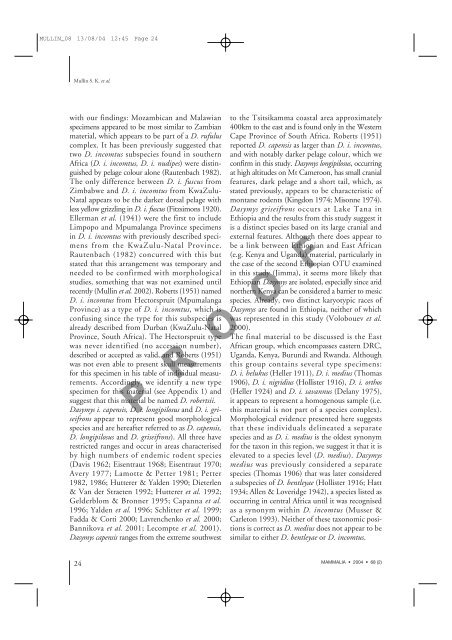
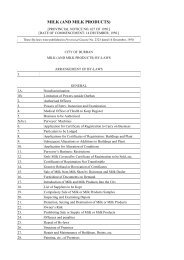
![INK Environmental Sustainability Booklet [19 MB] - Durban](https://img.yumpu.com/22025104/1/190x136/ink-environmental-sustainability-booklet-19-mb-durban.jpg?quality=85)

